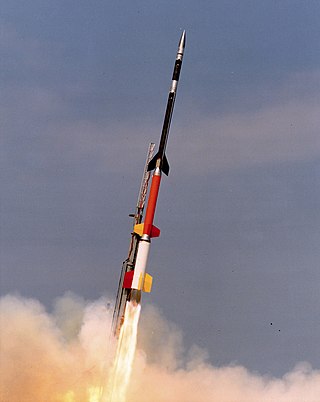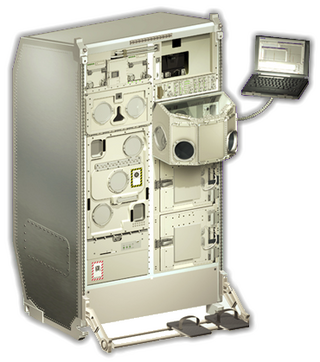MASER is a sounding rocket that is used in the MASER microgravity research rocket programme, operated by the Swedish Space Corporation (SSC). The main customer is the European Space Agency (ESA), particularly the EMIR and ELIPS programmes. MASER stands for "MAterials Science Experiment Rocket".
The launches take place at Esrange in Northern Sweden. Throughout its sub-orbital flight, the programme offers 6–7 minutes of microgravity aboard the rocket and full recovery of experimental modules with helicopter immediately after flight.
| Mission | Date | Launch site | Motor | Apogee | Payload | Modules | Comments | Reference report |
|---|---|---|---|---|---|---|---|---|
| MASER 1 | 1987 Mar 19 | Esrange | Black Brant 9B | 295 km | ||||
| MASER 2 | 1988 Feb 29 | Esrange | Black Brant 9C | 318 km | ||||
| MASER 3 | 1989 Apr 10 | Esrange | Black Brant 9C | 297 km | CIS-1, TEM 06-15 | [1] | ||
| MASER 4 | 1990 Mar 29 | Esrange | Black Brant 9B | 317 km | CIS-2 | [1] | ||
| MASER 5 | 1992 Apr 9 | Esrange | Black Brant 9 | 309 km | CIS-3 | [1] | ||
| MASER 6 | 1993 Nov 4 | Esrange | Skylark 7 | 243 km | 372 kg | 5/ESA | Esrange EKMA93-12 | |
| MASER 7 | 1996 May 3 | Esrange | Skylark 7 | 252 km | 355 kg | 4/ESA | Esrange EUK113-9616 | |
| MASER 8 | 1999 May 14 | Esrange | Skylark 7 | 260 km | 334 kg | 4/ESA | Esrange SUM8251-D18 | |
| MASER 9 | 2002 Mar 16 | Esrange | Skylark 7 | 258 km | 347 kg | 3/ESA | Esrange SUM92-S14 | |
| MASER 10 | 2005 May 2 | Esrange | Skylark 7 | 252 km | 350 kg | 4/ESA | 441st and final Skylark | Esrange SUM1025-S8 |
| MASER 11 | 2008 May 15 | Esrange | VSB-30 | 252 km | 383 kg | 5/ESA | Esrange EUK175-E60 | |
| MASER 12 | 2012 Feb 13 | Esrange | VSB-30 | 250 km | 390 kg | [2] | ||
| MASER 13 | 2015 Dec 1 | Esrange | VSB-30 | 260 km | 277 kg | [3] | ||
| MASER 14 | 2019 Jun 24 | Esrange | VSB-30 | 260 km | 400 kg | MASER 14 | ||
| MASER 15 | 2022 Nov 23 | Esrange | VSB-30 | 260 km | 270 kg | |||
As humans subjected to weightlessness or microgravity undergo physiological changes, [4] there is an increasing interest in biological research. Aside from the material science aspect being investigated aboard the MASER13-15 rockets, biological modules aim to fulfill this purpose and elucidate this side of space-related research. [5]

The International Space Station (ISS) is a large space station assembled and maintained in low Earth orbit by a collaboration of five space agencies and their contractors: NASA, Roscosmos (Russia), JAXA (Japan), ESA (Europe), and CSA (Canada). The ISS is the largest space station ever built. Its primary purpose is to perform microgravity and space environment experiments.

A sounding rocket or rocketsonde, sometimes called a research rocket or a suborbital rocket, is an instrument-carrying rocket designed to take measurements and perform scientific experiments during its sub-orbital flight. The rockets are used to launch instruments from 48 to 145 km above the surface of the Earth, the altitude generally between weather balloons and satellites; the maximum altitude for balloons is about 40 km and the minimum for satellites is approximately 121 km. Certain sounding rockets have an apogee between 1,000 and 1,500 km, such as the Black Brant X and XII, which is the maximum apogee of their class. Sounding rockets often use military surplus rocket motors. NASA routinely flies the Terrier Mk 70 boosted Improved Orion, lifting 270–450-kg (600–1,000-pound) payloads into the exoatmospheric region between 97 and 201 km.

A reduced-gravity aircraft is a type of fixed-wing aircraft that provides brief near-weightless environments for training astronauts, conducting research, and making gravity-free movie shots.

Esrange Space Center is a rocket range and research centre located about 40 kilometers east of the town of Kiruna in northern Sweden. It is a base for scientific research with high-altitude balloons, investigation of the aurora borealis, sounding rocket launches, and satellite tracking, among other things. Located 200 km north of the Arctic Circle and surrounded by a vast wilderness, its geographic location is ideal for many of these purposes.

Animals in space originally served to test the survivability of spaceflight, before human spaceflights were attempted. Later, many species were flown to investigate various biological processes and the effects microgravity and space flight might have on them. Bioastronautics is an area of bioengineering research that spans the study and support of life in space. To date, seven national space programs have flown animals into space: the United States, Soviet Union, France, Argentina, China, Japan and Iran.

The Swedish Space Corporation, SSC, also registered as Svenska rymdaktiebolaget, is a Swedish space services company. SSC operations consist of launches of sounding rockets and stratospheric balloons, tests of future generation rocket engines and new rocket fuels, operation and maintenance of space and aviation systems, as well as satellite communications through the use of SSC ground stations deployed around the world. SSC is also working on developing its Space Surveillance Tracking (SST) and Space Traffic Management (STM) programs with the aim to identify, assess and minimize risks of collisions and disruptions associated with space debris.

Biolab is a single-rack multi-user science payload designed for use in the Columbus laboratory of the International Space Station. Biolab support biological research on small plants, small invertebrates, microorganisms, animal cells, and tissue cultures. It includes an incubator equipped with centrifuges in which the preceding experimental subjects can be subjected to controlled levels of accelerations.

Maxus is a sounding rocket that are used in the MAXUS microgravity rocket programme, a joint venture between Swedish Space Corporation and EADS Astrium Space Transportation used by ESA. It is launched from Esrange Space Center in Sweden and provides access to microgravity for up to 14 minutes.
TEXUS is a European/German sounding rocket programme, serving the microgravity programmes of ESA and DLR. The launches are conducted from Esrange in Sweden.
A number of suborbital spaceflights were conducted during 2008. These consist mostly of sounding rocket missions and missile tests, and include other flights such as an ASAT firing. Between the start of the year and 16 July, at least 43 publicly announced suborbital spaceflights were conducted, the first of them on 11 January.

Weightlessness is the complete or near-complete absence of the sensation of weight, i.e., zero apparent weight. It is also termed zero g-force, or zero-g or, incorrectly, zero gravity.

The International Space Station is a platform for scientific research that requires one or more of the unusual conditions present in low Earth orbit. The primary fields of research include human research, space medicine, life sciences, physical sciences, astronomy and meteorology. The 2005 NASA Authorization Act designated the American segment of the International Space Station as a national laboratory with the goal of increasing the use of the ISS by other federal agencies and the private sector.
ELIPS - European Programme for Life and Physical Sciences in Space and applications utilising the International Space Station started in 2001 and was intended to cover the activities for the following 5 years. This Microgravity Programme at the European Space Agency (ESA) is an optional programme, with currently 17 ESA member states participating. The ELIPS programme prepares and performs research on the International Space Station, and other uncrewed mission platforms like Sounding Rockets, in fundamental and applied life and physical sciences. ELIPS is the continuation of the earlier European microgravity programmes EMIR 1&2, and the Microgravity Facilities for Columbus, MFC.

The Mobile Rocket Base, abbreviated MORABA, is a department of the DLR Space Operations and Astronaut Training in Oberpfaffenhofen near Munich. Since the 1960s, the MORABA has performed scientific high altitude research missions with unmanned rockets and balloons, and has developed the required mechanical and electrical systems. Their operational areas include upper atmosphere research, microgravity research, astronomy, geophysics, materials science, as well as hypersonic research.
Foton-M No.4 is a Russian microgravity and bioscience research spacecraft launched in July 2014 as part of the Foton programme. It is the fourth spacecraft in the Foton-M series, and the first to use the 34KSM configuration incorporating the equipment module from a Yantar satellite in place of that of a Zenit on earlier missions.
The following page is a list of scientific research that is currently underway or has been previously studied on the International Space Station by the European Space Agency.

The Space Rider is a planned uncrewed orbital lifting body spaceplane aiming to provide the European Space Agency (ESA) with affordable and routine access to space. Contracts for construction of the vehicle and ground infrastructure were signed in December 2020. Its maiden flight is currently scheduled for the third quarter of 2025.

The REXUS/BEXUS programme is a cooperation between the German Aerospace Center (DLR) and the Swedish National Space Agency (SNSA) that allows students from higher education institutions to study experiments on board sounding rockets and stratospheric balloons. Through a collaboration with the European Space Agency (ESA), the opportunity has been made available for students across all ESA Member States, Slovenia and Canada. The Swedish Space Corporation (SSC) and the Mobile rocket base (MORABA) of DLR are responsible for the launch. Students are getting support from experts of DLR, ESA, SSC and ZARM. The programme started in 2007.

SpaceX CRS-24, also known as SpX-24, was a Commercial Resupply Service mission to the International Space Station launched on 21 December 2021, at 10:07:08 UTC. The mission is contracted by NASA and is flown by SpaceX using a Cargo Dragon. This is the fourth flight for SpaceX under NASA's CRS Phase 2 contract awarded in January 2016.
The German space programme is the set of projects funded by the government of Germany for the exploration and use of outer space. The space programme is run by the German Aerospace Center, who conduct research, plan, and implement the programme on behalf of the German federal government.